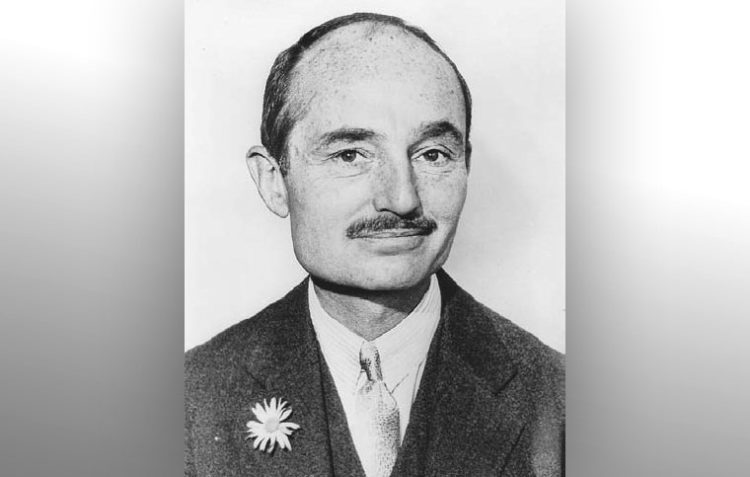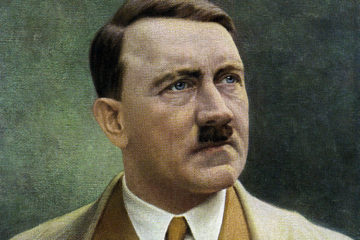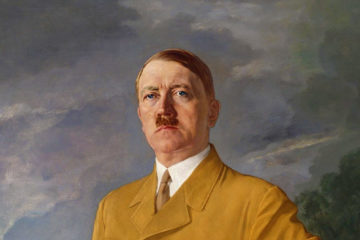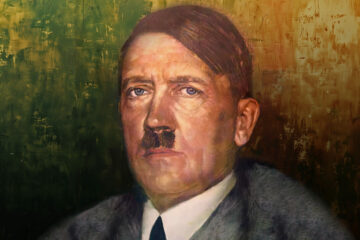The History of American National Socialism — Part IV: 1942-1945 (The War Years)

by Martin Kerr
THE JAPANESE ATTACKED Pearl Harbor on December 7, 1941. The next day the German-American Bund burnt its membership lists and other sensitive documents, and dissolved itself. Three days later, Hitler declared war on the United States.
With very few exceptions, which will be discussed below, the other American NS and pro-NS groups followed the Bund’s lead. But the Bund’s 25,000 members did not simply evaporate, nor did they cease believing in National Socialism. The America First Committee, associated with Charles Lindbergh, had 800,000 members. Most of these people, if not all, were broadly sympathetic to Hitler’s Germany. They, too, did not simply cease to exist when their movement formally shut down its operations on December 10.
The first reaction of the rank-and-file adherents and sympathizers of National Socialism was to go to ground. They hoped that the crackdown they expected would pass them over if they kept a low profile, remained out of the public eye and did not cause trouble.
The leadership was a little bit warier: they knew that in the eyes of the government they were enemy agents operating in the American homeland in a time of war, and that they would not simply be ignored. They knew that they were in for a rough ride.
The Persecution of the Bund
Some Bund chapters did not accept the shutdown ordered by their national headquarters in New York to be absolute and binding, and continued operations for awhile on a reduced basis. But in short order, they, too, closed down. Then it was quiet for a while.
The last national leader of the Bund was George Froebose. He had been the Midwest district leader for the group when Gerhard Wilhelm Kunze, Fritz Kuhn’s successor, mysteriously disappeared in the autumn of 1941. As the most-senior-ranking Bund officer, he formally took over in Kunze’s place. But Froboese was in poor health, and allowed August Klapprott and others to run the Bund on a day-to-day basis. In the middle of June 1942, he was served with a subpoena and ordered to report to New York to answer questions about the Bund’s operations. He never made it. The official story was that he lay down on a railroad track in Waterloo, Indiana, and allowed a train to decapitate him. But although his death was ruled a suicide, Klapprott and others who knew him suspected foul play.
On July 7, 1942, the former leaders of the now-defunct Bund were arrested in coordinated nationwide raids by the FBI and other law enforcement agencies. Frederick Schraeder, editor of the Free American, died of a heart attack during the raid, when armed FBI agents broke into his house in the dead of night to arrest him. He was 83.
Since the Bund had conducted its operations with scrupulous legality, the government had to fabricate spurious charges in order to arrest its leaders. The Bundsmen were accused of “conspiring to … undermine the morale of the armed forces of the United States” by encouraging men of military age to avoid wartime service. (In point of fact, the Bund had issued a directive encouraging its members to comply with the draft.) The initial wave of arrests targeted the leadership, but other arrests followed in the succeeding months. Eventually, even individual members of the Bund’s youth organizations were tracked down. In some cases, they were pulled from their classrooms in front of other students, handcuffed, and marched away.
In October 1942, the Bund leaders were found guilty of “sedition” and sentenced to five years in prison. The majority were sent to a forced labor camp in Sandstone, Minnesota. The conditions there were rough. Some of the men died and others had their health shattered. Gustav Elmer, former Bund Organizational Secretary, suffered a mental breakdown, and was transferred to an insane asylum. Malnourishment cost August Klapprott all of his teeth, and put him in wheelchair. Once, before being sent to Sandstone, he had been brutally beaten by prison guards.
Although they were interned without trial, rank-and-file Bund members and their families who were rounded up fared better. Most of these were sent to a detention camp in Crystal City, Texas. There, the government built a complex of internment facilities, including those for Japanese and Italian Americans, as well as those of German descent. In all, some 7,000 Germans and German-Americans were imprisoned for the duration of the War.
In May 1943, former Bundesleiter Fritz Kuhn was paroled from New York’s Sing Sing prison, where he had been serving a sentence for allegedly embezzling Bund funds. He was then sent to Crystal City, where he enjoyed celebrity status among his fellow National Socialists.
Although not luxurious by any means, the conditions in the Crystal City camps were livable. Families were kept together, and private cottages were provided for the bigger families. The inmates largely governed themselves, and the Bund members organized their camp into a functioning National Socialist community. NS holidays were celebrated (such as Hitler’s birthday on April 20) and NS flags were proudly displayed. There was a camp newspaper published in German. Two schools were provided for youngsters: an “American” school run by the government, in which instruction was in English, and a “German” school run by the inmates, with German-language instruction. Most parents opted to send their children to the German school.
Following the War, the federal government slowly released the detainees. About 1,000 were repatriated to Germany. One of those sent back was Fritz Kuhn. He settled in Munich, where he died in poverty in December 1951, an unrepentant National Socialist to the end. The rest were allowed to stay. The last camp was closed in 1948 — three years after the end of the War.
Operations “Pastorius” and “Elster”
The government’s true rationale for the persecution of the Bund was not, as it falsely claimed, that the Bund was subverting the US military. Rather, it was the fear that if the Germans invaded the North American mainland the Bund would constitute a “fifth column” to assist the Wehrmacht. War propaganda had reached a fever pitch, to the point that most Americans believed that such an invasion was a real possibility.
But the Germans only landed men on US soil twice during the War, and in both cases the efforts proved so weak and poorly organized that they collapsed immediately, and never posed any threat to the US.
The first of these missions was “Operation Pastorius” (named after an early German-American settler in the New World). In June 1942, German submarines landed two four-man teams on the East Coast, one on Long Island, and one in Florida. The men were agents of the Abwehr (German military intelligence) and they had been tasked with sabotaging the US war effort. Two were American citizens, and the others German nationals who had lived in the US.
The effort disintegrated almost instantaneously, when two of the would-be saboteurs turned themselves in to the FBI and betrayed their comrades. The two traitors were sentenced to prison and the other six men were executed on August 8, after being convicted of espionage by a secret military tribunal.
Hitler was angry with Abwehr chief Admiral Wilhelm Canaris over the botched operation, and no further sabotage missions were launched against the United States.
In November 1944, two German agents were landed by submarine in Maine. Their assignment was to report on the production of war materials. The mission, called Operation Elster, also ended in disaster when the two agents were captured soon after landing. They were sentenced to prison.
The threat of a mass invasion of the US by Germany had been a phantom all along, and the Bund had played no role in assisting the miniscule efforts that did take place.
The Great Sedition Trial of 1944
President Franklin Roosevelt, who had been a frequent target of the German-American Bund and its Christian Nationalist allies, was not satisfied with the destruction of the Bund. He wanted every vestige of pro-Axis sentiment obliterated. Early in 1942, Roosevelt ordered Attorney General Francis Biddle to organize a comprehensive prosecution of NS and Fascist sympathizers and anti-Semites. The legal justification for this was to be the Smith Act, which made it illegal to call for the overthrow of the Federal government.
The government’s case was problematic from the beginning. The initial theory of the case was that those indicted were sympathetic to Hitler’s Germany and that had conspired together to help Hitler take over the United States. The first assumption was correct, that all of those under indictment to some degree or another had a favorable impression of National Socialist Germany. But, as a group, they were not united in either thought or action, and did not collectively “conspire” to do anything. And, certainly, there was no thought of aiding a German conquest of the US.
Nonetheless, the prosecution went ahead, indicting an ever-changing roster of defendants three different times before settling on a final list. Here are the 30 defendants (28 men and two women) listed in the final indictment. It constitutes an honor roll of National Socialists and Christian Nationalists from the 1930s and early 1940s. Many of those indicted were associated with more than one organization, but accompanying each name is the group with which each defendant was most prominently affiliated.
1. Garland L. Alderman – National Workers’ League
2. David Baxter – Social Republic Society
3. Howard Victor Broenstrupp – Silver Shirt Legion
4. Frank W. Clark – National Liberty Party
5. George E. Deatherage – National Workers’ League
6. Prescott Freese Dennett – Citizens Committee to Keep America Out of the War
7. Lawrence Dennis – Author of The Coming American Fascism, The Dynamics of War and Revolution and other books
8. Elizabeth Dilling – Patriotic Research Bureau
9. Hans Diebel – German-American Bund
10. Robert Edward Edmonston – Editor of the American Vigilante Bulletin
11. Ernst Friedrich Elmhurst – Pan-Aryan League
12. Franz K. Ferenz – German-American Bund
13. Elmer J. Garner – Editor of Publicity newsletter
14. Charles B. Hudson – Publicist
15. Ellis O. Jones – National Copperheads
16. August Klapprott – German-American Bund
17. Gerhard Wilhelm Kunze – German-American Bund
18. Lois de Lafayette Washburn – National Gentile League
19. William Robert Lyman, Jr. – National Workers’ League
20. Joseph E. McWilliams – Leader of the Christian Mobilizers, later renamed the American Destiny Party
21. Robert Noble – Friends of Progress
22. William Dudley Pelley – Leader of the Silver Shirt Legion
23. E.J. Parker Sage – National Workers’ League, Black Legion
24. Eugene Nelson Sanctuary – American Christian Defenders
25. Herman Max Schwinn – German-American Bund
26. Edward James Smythe – Protestant War Veterans of America
27. James True – Editor of Nation and Race magazine
28. Peter Stahrenberg – Leader of the American National-Socialist Party
29. George Sylvester Viereck – German American Fellowship Forum
30. Gerald. P. Winrod – Defenders of the Christian Faith
Notably missing from the list are Charles Lindbergh, Father Charles Coughlin and Fritz Kuhn. Lindbergh was hugely popular with the American public, who considered him to be a hero. Including him in the indictment would have made the prosecution’s case less believable and less sympathetic. Father Coughlin, known as the “radio priest” for his broadcast sermons, was indeed openly anti-Jewish — but he had an enormous following, and, to an extent, he enjoyed the backing of the Roman Catholic Church. So, he, too, was not charged. Fritz Kuhn was already in prison on separate charges, and had not been active politically in the run-up to the War.
The government’s original theory of the case, that the defendants comprised a conspiracy to aid Hitler in his conquest of the US, was clearly ridiculous, and was discarded before the proceedings began. In its place, the prosecution substituted the ploy that had worked for them in the case against the Bund: that the defendants conspired to undermine the US military. Specifically, they were charged with subverting the military by criticizing its commander-in-chief, President Franklin Roosevelt.
This, too, was a ludicrous theory: criticizing a sitting president has never been considered treason. But “undermining the military” had worked against the Bund, and the government hoped it would work this time too. O. John Rogge was the lead prosecution attorney; Edward C. Eicher was the judge. An indictment was handed down on January 3, 1944 and the trial began on April 17. The government’s case ran into problems immediately. The Bundsmen had been unpopular defendants, with a lazy and timid lawyer. This time, each of the 30 defendants had their own attorney, some of whom were experienced and aggressive. They challenged Rogge’s case at every turn. Some of the accused, such as Elizabeth Dilling, had powerful friends and connections. As the trial progressed, the media began to mock the prosecution for its ineptness.
On November 29, Judge Eicher died suddenly of a heart attack. A new judge was appointed. After reviewing the evidence that the prosecution had provided, he declared a mistrial and dismissed the indictments. Although Rogge was still enthusiastic about going forward with new charges, the Department of Justice had no stomach for renewing the case, and did not back him. The only allies he could find were the American Jewish Committee and the Communist Party, USA. In 1947, a Washington, DC, court of appeals upheld the dismissal.
But although the government failed to obtain the verdict it wanted, it achieved its primary objective: the trial crushed the Christian Nationalist movement. It rendered the most prominent and effective CN leaders politically impotent, it destroyed their organizations and publications, and it intimidated their rank-and-file followers into silence. Whatever base of support that National Socialists and Christian Nationalists had enjoyed previously was now gone: they and their cause were now anathemas among ordinary Americans.
The National Worker’s League
Despite the brutal persecution of the Bund, a few small pro-NS groups continued to solider on even after the War began. The most notable of these was the National Workers’ League, based in the Detroit area. The NWL was formed in 1938. Ostensibly, it was led by Sage Parker, Garland Alderman and William Lyman, but another man, Russell Roberts, made the most important policy decisions behind the scenes. Their publication was the typewritten Nationalist Newsletter.
The NWL concentrated it efforts on organizing White workers in Michigan and elsewhere in the Upper Midwest. It also was outspoken in its opposition to the War. In 1942, when racial fighting broke out between Whites and Blacks in Detroit, the NWL was in the forefront of organizing the White resistance.
The federal government decided that the League, which was building strength in the armaments industries, posed a potential threat to the War effort. In 1943, its newsletter was banned from the US mail, effectively terminating it, and subsequently the NWL ceased operations. In 1944, Parker, Alderman and Lyman were indicted in the “sedition” trial discussed earlier. Roberts, however, escaped prosecution. A successor group, the United Sons of America, took the place of the NWL, but it was only a pale reflection of the original group.
The Citizens Protective League
Although he is little-known today, Kurt Mertig was an influential National Socialist activist and organizer during the 1930s and 1940s . He was born in Germany and became a naturalized US citizen. In addition to being affiliated with the Bund and other groups, he also ran an organization of his own, the Citizens Protective League. The innocuously-named CPL pursued a hardline NS agenda while maintaining a low profile. In some respects, it resembled the National Alliance of Dr. William L. Pierce two generations later. Mertig and his associates rejected the uniformed marches of the Bund and the rabble-rousing speech-making of “Nazi Joe” McWilliams, and instead appealed to a sober, serious middle-class audience.
Before the War, the CPL held meetings every Monday evening in a hall in Yorkville, a German-American neighborhood of Manhattan. While the Bund and other groups disbanded after Pearl Harbor, Mertig continued his low-profile meetings without missing a beat. When, eventually, the CPL lost the use of the Yorkville meeting hall, Mertig shifted the location of his gatherings to the private homes of some his more-affluent members. This was done on a rotating basis, so that the CPL never met in the same place twice in a row.
Mertig escaped the sedition indictment, perhaps because the feds thought he was a small fish not worth their efforts. Nonetheless, in 1943 he was ordered to relocate inland, out of the three-hundred-mile “exclusion zone” that the military declared for the East and West coasts. Presumably, this was to prevent him from aiding the feared German invasion.
Mertig kept his small group together throughout the conflict, and in 1949 he used it as a membership base when he formed the National Renaissance Party, which will be discussed in subsequent installments of this series.
Other Movements
Although the purpose of this series is to specifically chronicle and analyze American National Socialism, there are a few other wartime developments of movements allied to National Socialism which should be mentioned.
- In 1942, Rev. Gerald L. K. Smith, former associate of Louisiana governor Huey Long and a champion of Christian Nationalism, founded The Cross and the Flag magazine, which was to be the banner publication of the CN movement into the 1970s.
- In the summer of 1944, the Internal Revenue Service, on orders from the Roosevelt regime, placed a lien on all assets of the Ku Klux Klan, effectively (but only temporarily) putting an end to it.
- In November 1944, Smith contested the presidential election as the candidate of the America First Party. He was on the ballot in only two states, and received a paltry 1,781 votes (1,531 in Michigan and 250 in Texas). This was the low-point of American racialism in the 20th century.
We should also mention the “Mothers Movement,” founded in 1939 after the outbreak of the War in Europe. It is sometimes known by its campaign name of “We, the Mothers.” Its initial goal was to prevent US entry into the War. After Pearl Harbor, it urged an end to the War through a negotiated peace. Prior to the Normandy D-Day, it vociferously opposed the “second front” invasion of Europe.
All of the groups that continued to fight on after the US entry into the War were weak and ineffective in the face of their main adversary, which was the Federal government. It is a testament to the strength of their beliefs and to their courage that they refused to bend the knee or give up the fight, despite the insurmountable odds that they faced.
The War in Europe came to an end on May 8, 1945. The Japanese formally surrendered on September 2. All charges were finally dismissed against the sedition trial defendants on May 18, 1946.
On August 16, 1946, Emory Burke founded the Columbian Workers Movement of America (or simply “the Columbians”) — and the work of rebuilding National Socialism in America commenced.
To be continued…
* * *
Source: New Order






Excellent history of the dissidents upon whose shoulders we stand today, Mr. Kerr. Next in the series is this 25 December release, Part Five, The pre-Rockwell Years: https://neworderorg.wordpress.com/2017/12/25/the-history-of-american-national-socialism-part-5-the-pre-rockwell-years-1946-1958/
I worked back to August Klapprott’s birthdate (9/4/’06) in his Metapedia profile to recall that on 9/4/’94, representing the National Alliance, I had the honor of meeting him on his 88th birthday at his South Carolina home, along with New Order Commander Matt Koehl, and several other notable invitees.
thank you ! as a german notknower i always wondered where have
all the american National Socialists of Roosevelts “peace”times gone .
i only did know there were many and i got some clue that Mayer
Lanskys + Lucky Lucianos mafia workings had something done by
FBIprotection .